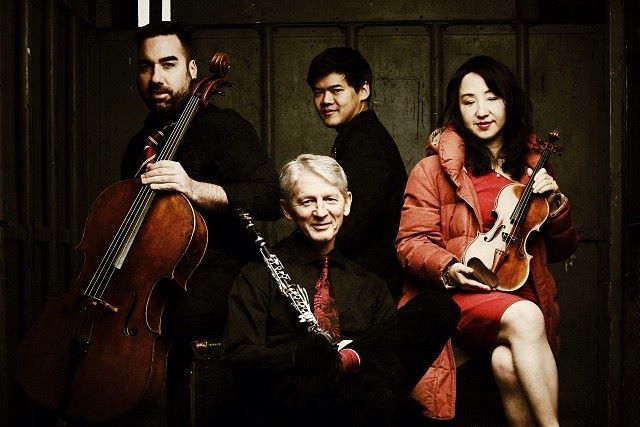Civitas Ensemble serves up vitality and emotion in season opener
The Civitas Ensemble’s season-opening program was the result of some late reshuffling. The first swap came with Thomas Adès’ mischievous Catch being replaced by John Williams’ more buttoned-down Air and Simple Gifts. The other was a change in personnel, with cellist Paula Kosower subbing for Civitas founding member Kenneth Olsen.
In spite of these last-minute tweaks, Civitas presented a polished, well-selected program at the Merit School of Music’s Gottlieb Hall that showcased the talent of its regular members —violinist Yuan-Qing Yu, clarinetist J. Lawrie Bloom, and pianist Winston Choi—as well as three guest artists: violinist Kozue Funakoshi, violist Wei-Ting Kuo, and Kosower. (All save for Choi and Kosower are members of the CSO.)
The first half of the concert was comprised entirely of pieces by living American composers, each given a brief introduction by one of Civitas’s three founding musicians. Leading off was John Williams’ Air and Simple Gifts, most famous for its widely-received premiere during President Barack Obama’s 2009 inauguration.
Civitas gave this most American of works a devoted, heartfelt interpretation. Excepting some balance problems in the latter part of the piece—during which a full-sticked piano overpowered the other instrumentalists—each line was artfully vocalized, enunciated by each musician as a singer floats a vocal line. Kosower, in particular, played with exquisite sensitivity and attention to detail, proving herself a stellar stand-in.
John Corigliano’s Snapshot: Circa 1909 for string quartet, brought CSO violinist Kozue Funakoshi onstage. Inspired by an old family photograph, the work opens with a sweeping solo for second violin meant to represent Corigliano’s father. (A mere violin-wielding tyke in the photo, the composer’s father John Corigliano Sr., would serve as concertmaster of the New York Philharmonic from 1943 to 1966.) Eventually, the second violin is joined by the first violin in a symbolic, time-transcending duet between the young Corigliano Sr. and his future self, over subdued accompaniment from the cello and viola.
The ensemble’s warm reading of the quartet lent itself to the folksy, fireside intimacy of Corigliano’s Snapshot, but probed deeper than its quaintness. The duet of Funakoshi and Yu—tinged with a sweet, nostalgic sadness—formed the emotional heart of the piece, which violist Kuo and cellist Kosower reinforced with subtle phrasings.
The evening’s newest work was also penned by the youngest composer, 30-year-old Roger Zare. His Geometries—a two-pronged essay inspired by geometric structures—is the latest of a number of math- and science-inspired compositions by the Evanston-based composer. The first movement, “Fractals,” takes its name from repeated patterns, and fittingly follows a fugal structure. Zare exploits the staggered entrance of each instrument on a unison pitch, coaxing the ear to zero in on changes in timbre. This was expertly handled by the ensemble members, who would enter almost indistinguishably atop one another before timbral shifts fully registered.
The second movement, “Tangents,” kicks off with sixteenth notes from the piano punctuated by offbeat accents. That sets the tone for an angular, rhythmically driven movement with contrasting moments of fluid lyricism.
Choi’s contribution here was spectacular, executing the demanding keyboard role with its decorative flourishes and percussive, double-fisted chords with full command. Indeed, the vivacious playing of the second movement by all the musicians provided the thrilling highlight of the evening, as well as making a strong case for the music of a promising composer.
Civitas closed the concert with a lush, impassioned account of Brahms’ Clarinet Quintet, which, as Bloom quipped, needed no introduction. It was clear that all of the players were on the same emotional plane, presenting a rendition that was as singular as it was unified. Bloom would lock into the phrasings of his colleagues and, instead of mimicking them directly, follow up with subtle shadings of his own that still operated within the group’s interpretive scope.
Collectively, Civitas breathed a vitality into Brahms’ classic that made it feel as fresh as the younger pieces on the program.
The Civitas Ensemble’s next concert is 3 p.m. February 28 at Gottlieb Hall. Program is TBA. civitasensemble.org.
Posted in Performances



